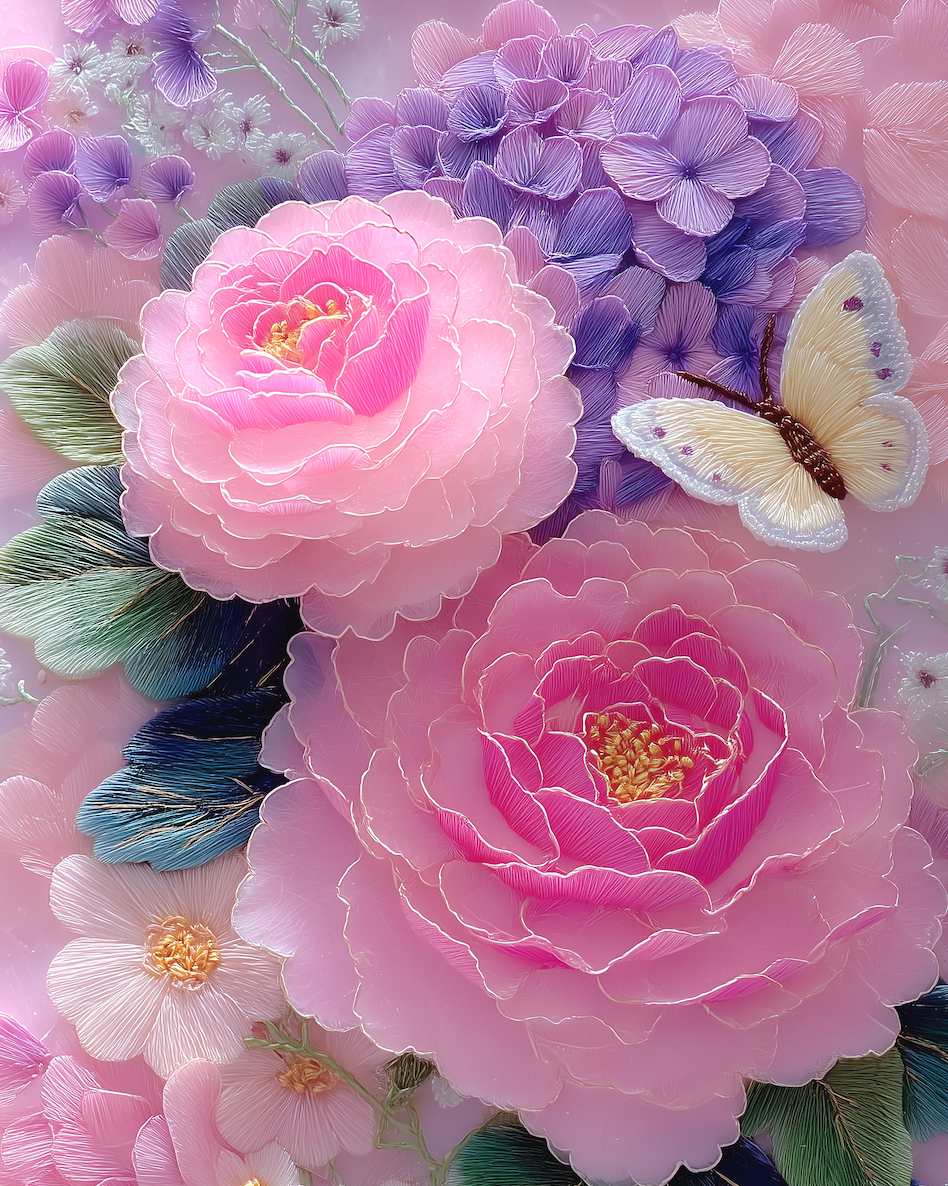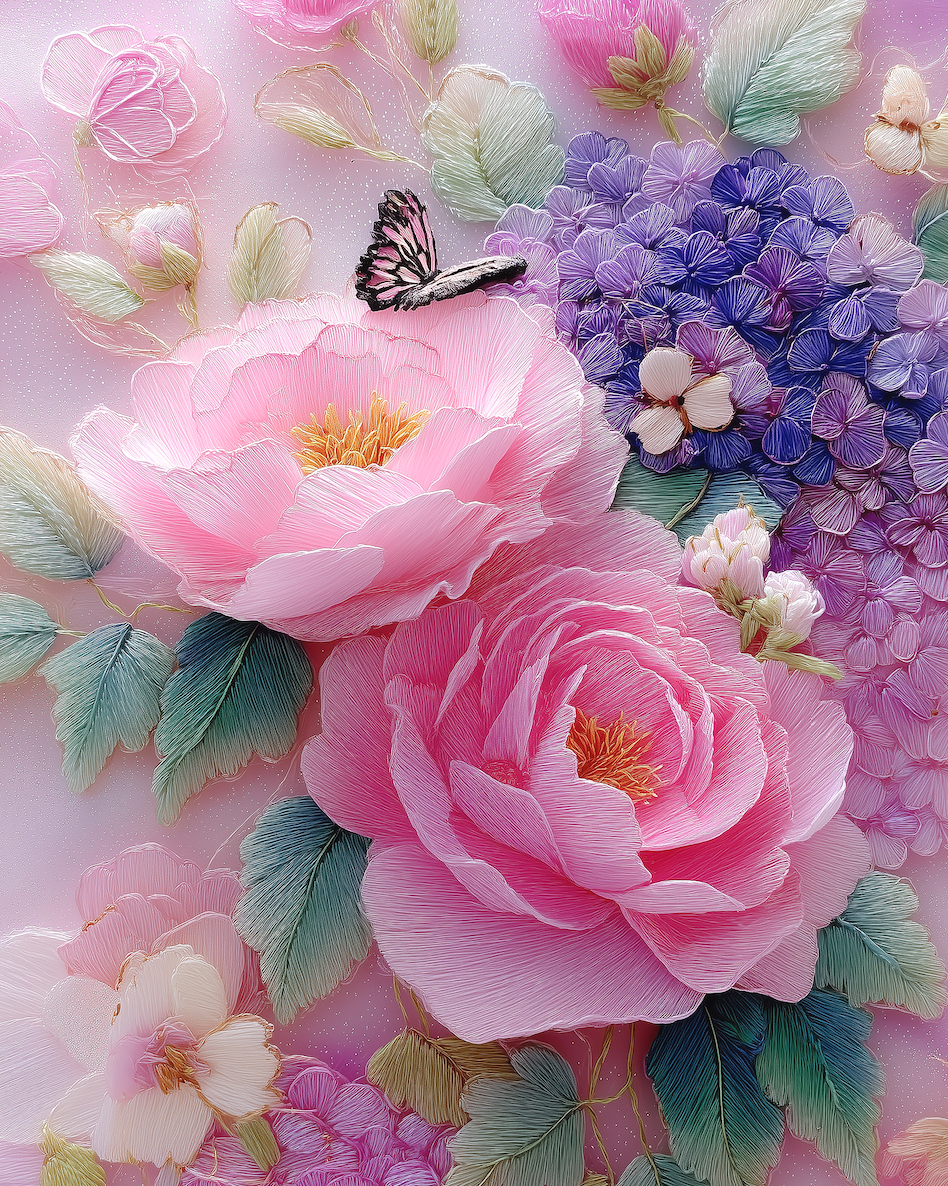In the world of slow taste, everything is clear and joyful
- 2025-06-02
- AI IMAGES

As the morning sun passed through the carved window lattice and landed on the decorative painting "Splendid Flowers | Slow Appreciation of the Human World, All Clear Joy" on the desk, the golden petals of peonies and the blue halo of embroidered balls stretched out into poetry in the light and shadow. The peonies and hydrangeas in the painting never show off their flamboyant posture, but weave a calm web between the interweaving of branches and leaves - peonies collect the moonlight of the prosperous Tang Dynasty with their folded petals, while hydrangeas fill the misty rain of Jiangnan with clusters of flower balls. The two whisper on the canvas, telling the story that the joys and sorrows of the world are simple simplicity after the decline of prosperity, and the secrets of time that can only be understood slowly.

The peonies in the painting always bloom in a lazy and solemn manner. The cinnabar red on the edge of the petals seems to be dyed by spring water, with a cloud like texture blending from thick to light. In the layers of folds, it seems like there are countless mornings that have been smoothed by time. The painter repeatedly stacked mineral pigments to create the thickness of the petals, and under sunlight, a subtle grainy texture could be seen, similar to the natural wax layer on peony petals, exuding a warm luster. The most touching thing is the golden powder staining at the center of the flower, which is not evenly applied, but naturally spreads out with the movement of the flower bud, resembling the pollen accidentally brushed on by bees while collecting honey, exuding a bit of casual vividness.

The embroidered ball interprets Qinghuan in another way. The embroidered balls in the painting are mostly gradient colors of light blue and pink purple. The flower balls are not regular circles, but rather slightly skewed, as if blown by last night's wind, with a swaying aftertaste. The painter used wet painting to process the petals of the embroidered ball, allowing the blue and purple to blend naturally on the rice paper, forming a hazy effect like watercolor, as if dew droplets condensed on the flower ball could be seen. In a painting depicting a rainy alley, several embroidered ball petals are scattered on the bluestone road, echoing the blue flower curtains hanging under the distant eaves. The entire scene is shrouded in a thin mist of blue, and the blue of the embroidered ball becomes the gentlest footnote in this world.

The combination of peonies and embroidered balls is full of the wisdom of Chinese aesthetics. The single blooming peony and the cluster of embroidered balls complement each other visually, creating a harmonious contrast between the intense red and light blue colors. The painter cleverly connected the two with vines. The branches of peonies are vigorous and powerful, while the branches of hydrangeas are flexible and graceful, one rigid and one soft, just like the way of relaxation in life. Peonies and hydrangeas in paintings are not only a representation of beauty, but also symbols of the accumulation of time. Peonies have been a symbol of wealth and prosperity since the Tang Dynasty, but the peonies in the paintings have shed the grandeur of the palace and added a touch of warmth from the common people. In a painting depicting the hutongs of old Beijing, a pot of ink colored peonies is placed on the windowsill of a quadrangle courtyard, with freshly dried persimmon cakes next to it. The red of the peonies and the orange of the persimmon cakes are particularly warm against the gray wall, as if telling the story of prosperity in ordinary days.

The embroidered ball carries the gentle atmosphere of the Jiangnan water town. The embroidered balls in the painting are often accompanied by white walls, black tiles, bamboo curtains, and wooden windows. In a painting depicting a tea house, a bowl of Bi Luo Chun is placed on a table by the window, and several blue embroidered balls are inserted into a celadon bottle next to it. The bamboo shadows outside the window fall through the window frame onto the canvas, overlapping with the flower shadows of the embroidered balls, forming a harmonious scene of movement and stillness. The embroidered ball here is no longer just a simple flower, but has become synonymous with slow life, reminding people of the comfortable feeling of "trying new tea with new fire, and enjoying poetry and wine in the prime of time". The combination of peonies and hydrangeas portrays different life scenes in the painting. In some paintings, peonies and hydrangeas are planted together in a pottery pot, and the warmth of peonies and the calmness of hydrangeas complement each other, as if telling different aspects of life; Some place the two on either side of the screen, connected by a winding path in the middle, implying the journey of life from prosperity to simplicity. These images all convey the same truth: Qinghuan is not a reclusive escape from the world, but slowing down in the hustle and bustle of the world to see true purity.
